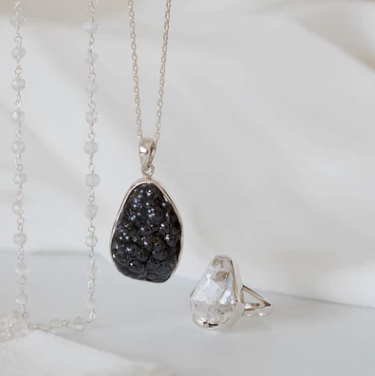Zebra Stone, known to many for its zebra-like patterns of dark red-brown on a pale backdrop, has left geologists and gemologists bewildered for decades as to how it came about. At first glance this may appear to be just another jasper but it is so much more, in fact it is not jasper at all. Perfectly capturing the essence of the Western Australian landscape, it has always been a favorite for crocodile carvings and paperweights. Today it is still a geological conundrum and becoming increasingly popular for statement gemstone jewelry.
Found only in the East Kimberly region of Western Australian this stone has been placed at 600 million years in the Upper Proterozoic era or Pre-Cambrian period. Colored red by ferric iron oxides and consisting of fine-grained siliceous argillite (indurate siltstone or claystone), Zebra Rock is classified as a clastic sedimentary stone. This simply means that it is formed by particles of other silicate minerals and rock fragments that have weathered and travelled by means of wind and water and deposited in a new location to create a new rock formation.
How the process of sedimentation formed the resulting regular pattern of banding throughout the stone is still not explained. Liesegang banding is one method that has been brought to the table however it doesn’t completely satisfy the argument. Liesegang banding refers to irregular rings and bands seen in some sedimentary stones although spots and evenly spaced bands/rods have never been described. Other methods of sedimentation suggest an iron rich solution that has infiltrated the uniformly white rock, or perhaps there was further deformation of the stone before it was completely solidified.
Bunny Bedi, owner and designer at Made In Earth, shares his experiences with this stone. “I’ll be honest, at first I wasn’t sure how the color pallet would go with my customers who are accustomed to a bright and colorful selection of crystal jewelry. Surprisingly, it was welcomed like a breath of fresh air. The cool natural tones contrast well against the bold patterns and each piece is individual, with a story to tell. It is an important Australian stone to have in our gemstone jewelry collection and is certainly popular with both men and women.”
Zebra stone looks plain and brown before cutting and polishing so it can be a bit of a gamble as to whether the resulting cabochons are going to have a spotted or banded pattern. Typically cut with a diamond saw each piece varies in hardness depending on the degree of porousness within that particular specimen.
It is realized that this stone poses an interesting problem of genesis and that we may never fully understand the mystery. We can however appreciate its beauty, in all the bands and spots it possesses within our Zebra Stone rings, pendants, bracelets and earrings here at Made In Earth.







